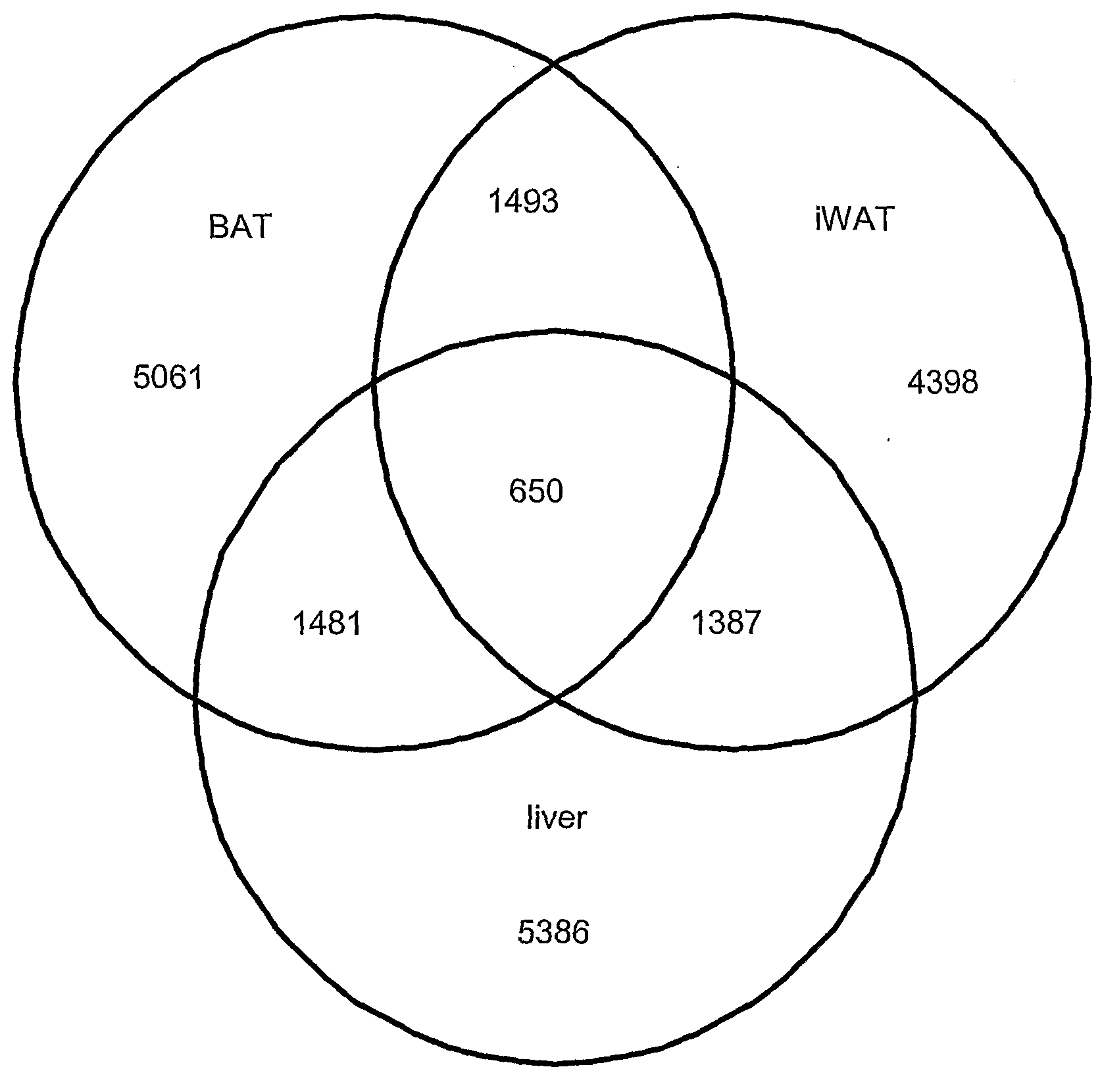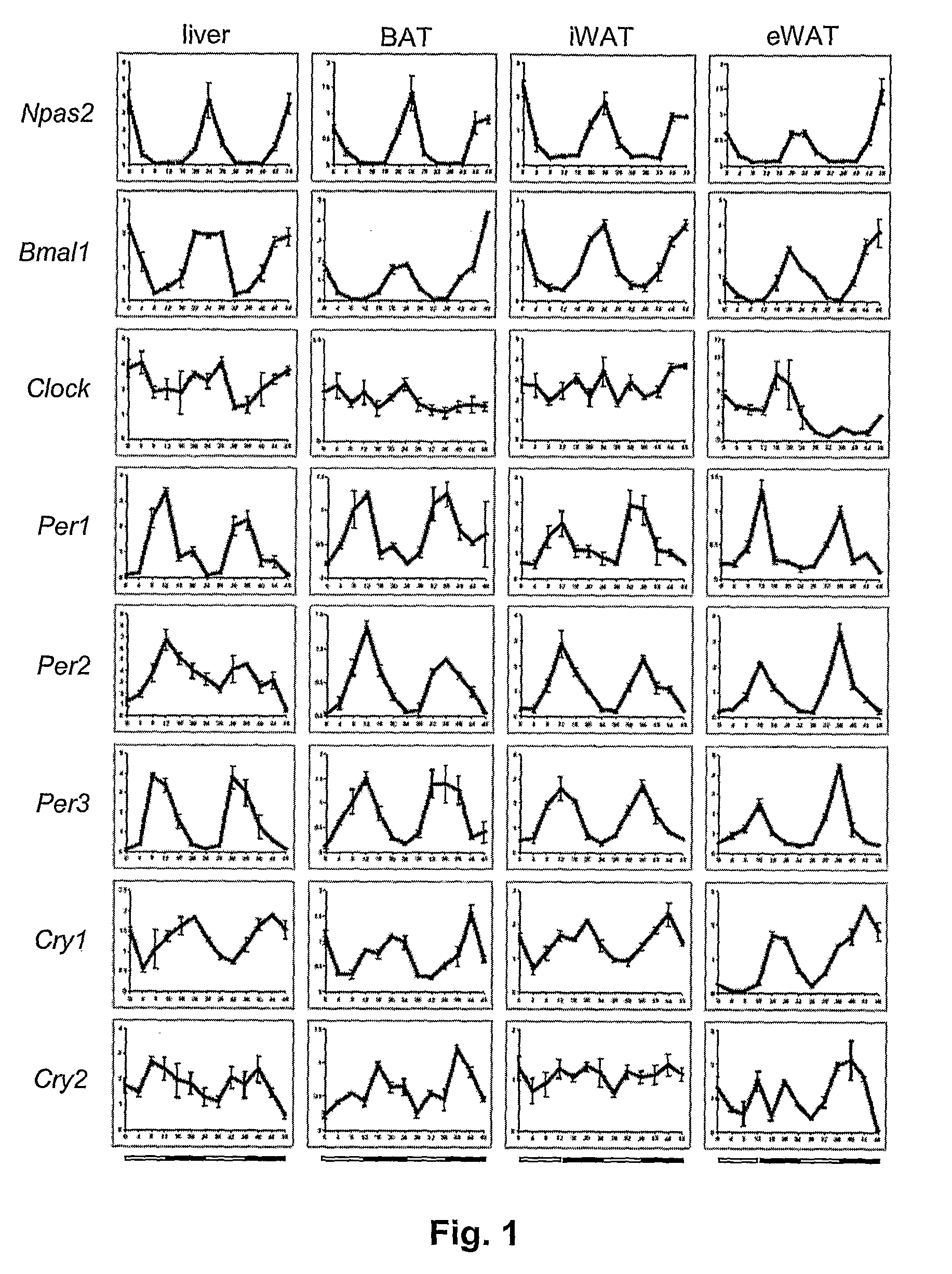Modulation of Peripheral Clocks in Adipose Tissue
a technology of adipose tissue and peripheral clock, which is applied in the direction of drug compositions, immunological disorders, metabolism disorders, etc., can solve the problems of reducing the expression of circadian rhythm, reducing the number of patients with cancer or aids, and reducing the number of patients with adipose tissue loss, so as to achieve the effect of prolonging the circadian rhythm
- Summary
- Abstract
- Description
- Claims
- Application Information
AI Technical Summary
Benefits of technology
Problems solved by technology
Method used
Image
Examples
example 1
Materials and Methods
[0043]All materials were obtained from Sigma / Aldrich (St. Louis, Mo.) or Fisher Scientific (Pittsburgh, Pa.) unless otherwise noted.
[0044]In Vivo Circadian Studies. Studies were conducted using 8-10 week old male AKR / J mice obtained from the Jackson Laboratories (Bar Harbor, Me.). The animals were acclimated to a regular chow diet (Purina 5015) ad libitum, under a strict 12-hr light: 12-hr dark cycle for 2 weeks. During this period, all animals were handled frequently by the staff to reduce the stress introduced by human contact. Following the acclimation period, animals were sacrificed in groups of 3 or 5 animals every 4 hr over a 48-hr period. Animals in the temporarily restricted feeding study were divided into a control cohort with ad libitum access to food and a Restricted feeding (RF) cohort with food access only during the 12-hr light period. Individual body weight and food intake were monitored daily for each animal during the 7-day restricted feeding pe...
example 2
Adipose Tissues Express Circadian Oscillator Mechanism Genes
[0056]To investigate and characterize the presence of active peripheral circadian clocks in adipose tissues, a qRT-PCR approach was used to examine the circadian gene expression patterns in liver, and in brown, inguinal, and epididymal adipose tissues (BAT, iWAT, and eWAT respectively), of 8-week old AKR / J mice. Tissues were harvested from three male, 8-week-old AKR / J mice every 4 h over a 48-h period (13 time points, n=3 in each time point). Total RNA was extracted from collected tissues and used for quantitative RT-PCR analysis of gene expression, as described in Example 1. All values were normalized with the corresponding Cyclophilin B levels. In FIG. 1, all values are reported as averages±SD. As shown in FIG. 1, robust cyclic expression was found in the majority of circadian oscillator genes examined. Npas2 and Bmal1 cycled in synchrony, reaching their zenith (highest levels) around zeitgeber (circadian) time (ZT) 0 (0,...
example 3
Circadian-Controlled Output Gene Oscillations in Adipose Tissues
[0060]The presence of active circadian clocks in BAT, iWAT, and eWAT was further investigated by examining the expression levels of several genes known to be circadian-controlled in other tissues. The peripheral tissues of mice described above in Example 2 were used to determine the expression patterns for addition genes using qRT-PCR. As shown in FIG. 2, the expression of Rev-erbα and Rev-erbβ oscillated in phase with the Per genes in BAT, iWAT, and eWAT; and reflected the pattern observed in liver. The expression of Dbp showed an oscillatory pattern similar to Per and Rev-erb genes (FIG. 2), while the expression of E4 bp4 followed a circadian profile approximately in phase to Npas2 and Bmal1, and out of phase with Dbp (FIG. 2). Stra13 expression in fat tissues, especially in iWAT, showed a strong oscillatory trend, but did not follow a specific circadian pattern. Although Arnt gene expression did not fluctuate signifi...
PUM
| Property | Measurement | Unit |
|---|---|---|
| Fraction | aaaaa | aaaaa |
| Time | aaaaa | aaaaa |
| Weight | aaaaa | aaaaa |
Abstract
Description
Claims
Application Information
 Login to View More
Login to View More - R&D
- Intellectual Property
- Life Sciences
- Materials
- Tech Scout
- Unparalleled Data Quality
- Higher Quality Content
- 60% Fewer Hallucinations
Browse by: Latest US Patents, China's latest patents, Technical Efficacy Thesaurus, Application Domain, Technology Topic, Popular Technical Reports.
© 2025 PatSnap. All rights reserved.Legal|Privacy policy|Modern Slavery Act Transparency Statement|Sitemap|About US| Contact US: help@patsnap.com



